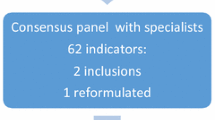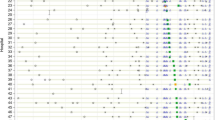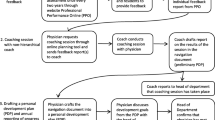Abstract
The Italian Society of Internal Medicine has developed a voluntary program of professional accreditation of the medical units run by its constituency. Participation in the program, which is meant to foster staff involvement in clinical governance, includes all the medical personnel and nurses. Accreditation is awarded provided the candidate unit is able to adhere to a pre-established set of quality standards, meet a number of clinical and organizational requirements and monitor specific indicators. Self-evaluation is the first step in the program, followed by a site visit by a team of peer internists experienced in quality auditing. The program, which has involved so far 19 units, has considered a number of clinical requirements related to the three most frequent diseases in Italian internal medicine wards: chronic heart failure (CHF), exacerbation of chronic obstructive pulmonary disease (COPD) and hepatic cirrhosis with ascites (HCA). The comparison between self- and peer-evaluation witnessed less discrepancies for disease-related than for organizational requirements, the latter being met to a smaller degree by most units. In particular, concordance was higher for requirements and indicators pertaining to CHF and HCA than to COPD. This program of professional accreditation developed by the Italian Society of Internal Medicine has the potential to describe, monitor and improve clinical and organizational performances in internal medicine. It should also be seen as a contribution to implement the strategy of professional governance in hospitals.






Similar content being viewed by others
References
Donabedian A (1980) Explorations in quality assessment and monitoring: The definition of quality and approaches to its assessment. Health Administration Press, Ann Arbor, Michigan
Berwick DM (1992) Heal thyself or heal thy system: can doctors help to improve medical care? Qual Health Care 1(Suppl):S2–S8
Moss F (1992) Achieving quality in hospital practice. Qual Health Care 1(Suppl):S17–S19
Berwick DM (2003) Disseminating innovations in health care. JAMA 289:1969–1975
Werner RM, Bradlow ET, Asch DA (2008) Does hospital performance on process measures directly measure high quality care or is it a marker of unmeasured care? Health Serv Res 43:1464–1484
UNI EN ISO 9001:2008. http://www.iso.org/iso/iso_9000_essentials. Accessed 3 Aug 2011
Werner RM, McNutt R (2009) A new strategy to improve quality. Rewarding actions rather than measures. JAMA 301:1375–1377
Wade J (2002) Is ISO 9000 really a standard? ISO management systems—May–June, 17–20
Joint Commission International. http://www.jointcommissioninternational.org/. Accessed 3 Aug 2011
http://www.simi.it/attivita/accreditamento/. Accessed 3 Aug 2011
National Collaborating Centre for Chronic Conditions (NICE) (2003) Chronic heart failure—management of chronic heart failure in adults in primary and secondary care. http://www.nice.org.uk
AmericanCollege of Cardiology Foundation, American Heart Association (ACC-AHA) (2005) Guideline update for the diagnosis and management of chronic heart failure in the adult. J Am Coll Cardiol 46:1–82
Heart Failure Society of America (HFSA) (2006) Comprehensive heart failure practice guideline. J Card Fail 12:e1–e122
Scottish Intercollegiate Guidelines Network (SIGN) (2007) Management of chronic heart failure. http://www.sign.ac.uk
European Society of Cardiology (ESC) (2008) Guidelines for the diagnosis and treatment of acute and chronic heart failure. Eur Heart J 29:2388–2442
ATS/ERS (2004) Standards for the diagnosis and treatment of patients with COPD: a summary of the ATS/ERS position paper. Eur Respir J 23:932–946
National Collaborating Centre for Chronic Conditions, National Institute for Health and Clinical Excellence (NICE) (2004) National clinical guideline on management of chronic obstructive pulmonary disease in adults in primary and secondary care. http://www.nice.org.uk
Global Initiative for Chronic Pulmonary Disease (GOLD) (2008) Global strategy for the diagnosis, management and prevention of chronic obstructive pulmonary disease. http://www.goldcopd.com
Thoracic Society of Australia and New Zealand (2008) The COPD-X Plan: Australian and New Zealand guidelines for the management of chronic obstructive pulmonary disease. http://www.copdx.org.au
Associazione Italiana per lo Studio del Fegato (AISF). Raccolta documenti AISF 1996–2001. Diagnosi e trattamento del paziente ascitico
American Association for the Study of Liver Disease (AASLD) (2004) Management of adults patients with ascites due to cirrhosis. Practice guidelines. Hepatology 39:841–856
Moore KP, Aithal GP (2006) Guidelines on management of ascites in cirrhosis. Gut 55:1–12
Ministero della salute. Ufficio VI. Dir. Gen. della Programmazione sanitaria, dei Livelli di assistenza e dei Principi etici di sistema. Analisi preliminare. Luglio 2009. http://www.salute.gov.it/imgs/C_17_pubblicazioni_1310_allegato.pdf
Thornton GC (1980) Psychometric properties of self-appraisals of job performance. Personnel Psychol 33:263–271
Bose S, Oliveras E, Edson WN (2001) How can self-assessment improve the quality of healthcare? Operations research issue paper 2(4). Published for the U.S. Agency for International Development (USAID) by the Quality Assurance (QA) Project, Bethesda, and JHPIEGO Corporation, Baltimore
Davis DA, Mazmanian PE, Fordis M, Van Harrison R, Thorpe KE, Perrier L (2006) Accuracy of physician self-assessment compared with observed measures of competence. A systematic review. JAMA 296:1094–1102
John OP, Robins RW (1994) Accuracy and bias in self-perception: Individual differences in self-enhancement and the role of narcissism. J Pers Soc Psychol 66:206–219
Crump B (2008) The good indicators guide: understanding how to use and choose indicators. NHS Institute for Innovation and Improvement, Bethesda
Danzi L (2008) High quality care for all. NHS Institute for Innovation and Improvement. Final report. Framing document, Bethesda
Braithwaite J, Greenfield D, Westbrook J, Pawsey M, Westbrook M, Gibberd R, Naylor J et al (2010) Health service accreditation as a predictor of clinical and organisational performance: a blinded, random, stratified study. Qual Saf Health Care 19:14–21
Cowan DT, Wilson-Barnett J, Norman IJ (2007) A European survey of general nurses’ self assessment of competence. Nurse Educ Today 27:452–458
Acknowledgments
The authors are indebted to Professor Pier Mannuccio Mannucci who devised and launched this program when he was President of the Italian Society of Internal Medicine. Professor Giuseppe Licata continued to support enthusiastically this program during his term of office. Professor Francesco Violi, current President, is actively engaged in the implementation of the program.
Conflict of interest
None.
Author information
Authors and Affiliations
Corresponding author
Appendices
Appendix 1: Internal medicine wards participating to the program of professional accreditation of the Italian Society of Internal Medicine
-
Medicina A, ASL Asti, Ospedale “C. Massaia”, Asti, Chief: Walter Saracco, M.D.
-
Medicina Interna, AO S. Croce e Carle, Ospedale S.Croce, Cuneo, Chief: Luigi Fenoglio, M.D.
-
S.C. Medicina, ASL Torino 4, Ospedale di Ciriè, Chief:Roberto Quadri, M.D.
-
Medicina Generale ad indirizzo geriatrico, IRCCS Istituto Auxologico Italiano, Ospedale S.Luca, Milano, Chief: Daniela Mari, M.D.
-
Medicina Interna 2–3, IRCCS Fondazione Ca’ Granda Policlinico, Milano, Chief: Pier Mannuccio Mannucci, M.D.
-
Medicina III, AO L.Sacco, Milano, Chief: Michele Cortellaro, M.D.
-
Medicina Generale, AO Provinciale Pavia, Osp.Carlo Mira, Casorate Primo, Chief: Esio Ronchi, M.D.
-
Medicina Interna A, Ospedale Maggiore “C.A. Pizzardi”, Azienda USL di Bologna, Chief: Vincenzo Arienti, M.D.
-
Medicina Interna 1, AO San Camillo Forlanini, Ospedale San Camillo, Roma,Chief: Laura Gasbarrone, M.D.
-
Medicina Interna II, Università Cattolica, Policlinico Gemelli, Roma, Chief: Raffaele Landolfi, M.D.
-
Medicina e Rep. Breve Osservazione—PS, Ospedale “S.Giovanni Calibita” FBF Isola Tiberina di Roma, Chief: Filippo Alegiani, M.D.
-
Medicina Interna per l’Urgenza, AO S.Giovanni Addolorata-Britannico, Roma, Chief: Giannantonio Cerqua, M.D.
-
Medicina Interna e Clinica Medica, ASL 106 Teramo, Ospedale G. Mazzini, Chief: Dario Di Michele, M.D.
-
Medicina Interna/Lungodegenza, ASL/BR Brindisi, PO Francavilla Fontana—Ceglie, Chief: Carmelo Sconosciuto, M.D.
-
Medicina, AO “Cardinale Panico”, Tricase, Chief: Maria Grazia Serra, M.D.
-
Medicina Interna, ASP di Cosenza, P.O. “Giannelli” di Cetraro, Chief: Giuseppe Musca, M.D.
-
Medicina Interna, ASP VV/Calabria, Presidio “I. Toraldo”, Tropea, Chief: Cesare Bianco, M.D.
-
Medicina Interna e Cardioangiologia, AOU Policlinico “P.Giaccone”, Palermo, Chief: Giuseppe Licata, M.D.
-
Medicina, Ospedale S. Elia, Caltanisetta, Chief: Federico Vancheri, M.D.
Appendix 2: Peer internists involved in the evaluation process in the frame of the program of professional accreditation of the Italian Society of Internal medicine
-
Abbita Giuseppe, M.D., Ospedale di Pantelleria Erice
-
Bianchi Giovanni Battista, M.D., Ospedale SS. Capitanio e Gerosa, Lovere
-
De Feudis Lucrezia, M.D., PO di Pescara
-
Fenoglio Luigi, M.D., ASO S. Croce e Carle, Cuneo
-
Fugazza Luciano, M.D., Ospedale Civico Codogno
-
Liberato Nicola Lucio, M.D., Ospedale Carlo Mira, Casorate Primo
Rights and permissions
About this article
Cite this article
Vanoli, M., Traisci, G., Franchini, A. et al. A program of professional accreditation of hospital wards by the Italian Society of Internal Medicine (SIMI): self- versus peer-evaluation. Intern Emerg Med 7, 27–32 (2012). https://doi.org/10.1007/s11739-011-0684-6
Received:
Accepted:
Published:
Issue Date:
DOI: https://doi.org/10.1007/s11739-011-0684-6




